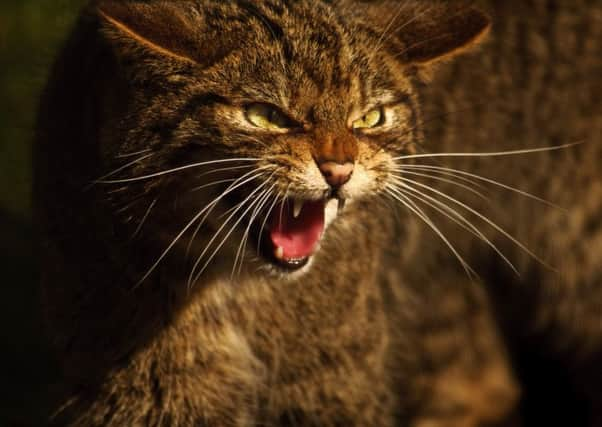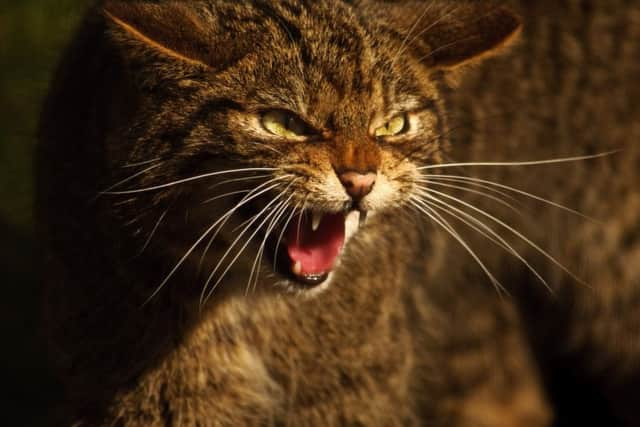Is this one of Scotland's last true wildcats?


They claim the animal, which was recorded on a private estate in Aberdeenshire, is the first living cat to have achieved the maximum score on the officially accepted wildcat identification checklist.
The Scottish wildcat, the UK’s only surviving native feline, is one of Europe’s most endangered mammals.
Advertisement
Hide AdAdvertisement
Hide AdThe biggest threat to its existence comes from cross-breeding with domestic and stray cats that share its territory.


Scientists have estimated there could be as few as 35 purebred individuals left, though others say the species has already been hybridised into extinction.
The new footage was captured earlier this year in the Huntly area by local man Kevin Bell, who was volunteering for the privately run conservation group Wildcat Haven.
Field workers have named the rare cat, believed to be a female, Phoenix because she signifies the species has “risen from the dead”.
Phoenix was first spotted around two years ago and is thought to be one of at least ten true wildcats living in the area.


Dr Paul O’Donoghue, chief scientific advisor for Wildcat Haven said: “It feels a bit like looking at a unicorn.
“This animal is so often described as extinct, bordering on mythical, but we have always been confident they’re still out there, and here’s the evidence coming from quite an unexpected place.
“No one has ever seen a wildcat this good in the wild before. It shows no signs of hybridisation and proves that Scotland’s iconic wildcat, an incredible survivor, is still out there despite all odds.”
Advertisement
Hide AdAdvertisement
Hide AdA state-backed emergency plan, Scottish Wildcat Action (SWA), was launched in 2013 to halt decline of the species by 2020.
Work, which includes a trap, neuter, vaccinate and release programme for feral cats, is focused on six priority areas identified as potential hotspots for any surviving wildcats – in Morvern, Strathpeffer, Strathbogie, northern Strathspey, Strathavon and the Angus glens.
Dr Andrew Kitchener is principal curator of vertebrate biology at National Museums Scotland, which has historical wildcat remains in its collections and is one of more than 20 partner organisations in the SWA group.
He has devised a scoring system which sets out 21 markers that define a true wildcat.
“I welcome the opportunity to look at any evidence of the Scottish wildcat in the wild and regularly examine evidence brought to my attention by members of the public or conservation groups,” he said.
“Wildcat Haven approached me to comment on this video footage, which shows one cat in the wild.
“The animal displays a number of characteristics of the Scottish wildcat, however not all of the characteristics which are used to identify the Scottish wildcat are visible in the video.”
He said the purity of any suspected Scottish wildcat could only be confirmed definitively through genetic testing, which has not been carried out on this particular animal.
Advertisement
Hide AdAdvertisement
Hide AdHe added: “While the cat in this video shows a high number of characteristics of the Scottish wildcat, there is not yet sufficient evidence to fully determine its purity.
“Since the video shows one cat, it is also not sufficient evidence of a ‘population’ of pure Scottish wildcats.”
SWA researchers have confirmed they believe true wildcats still exist in Aberdeenshire, where they have spotted 10 classed as “good examples” because of their coat markings, or pelage.
They say Phoenix is likely to be one of these.
“The wildcat shown in this ‘new’ video is extremely similar to one we have already identified,” a spokesman for SWA said.
“Scottish Wildcat Action continues its work to protect one of Scotland’s most endangered species.
“Our work in Aberdeenshire has already involved the trapping, neutering and release of almost 100 cats in an area we know to be close to a wildcat population.
“In addition to our extensive field work, we feel it’s vital that we have the support of the Scottish wildcat conservation breeding programme and studbook through RZSS (Royal Zoological Society of Scotland).
“This is another important conservation tool available to Scottish Wildcat Action and one that may be needed if we are to save the species from extinction.”